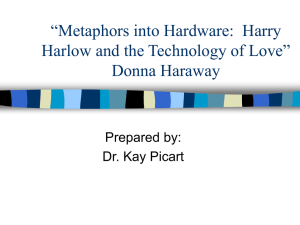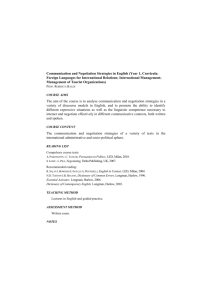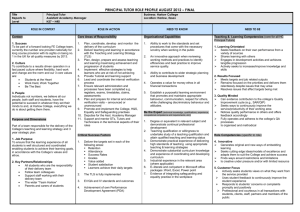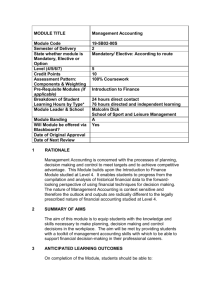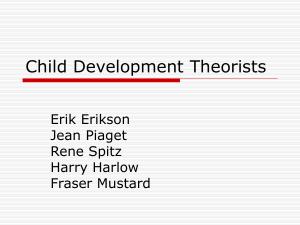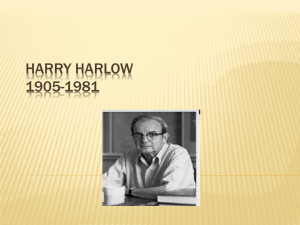PsycCRITIQUES
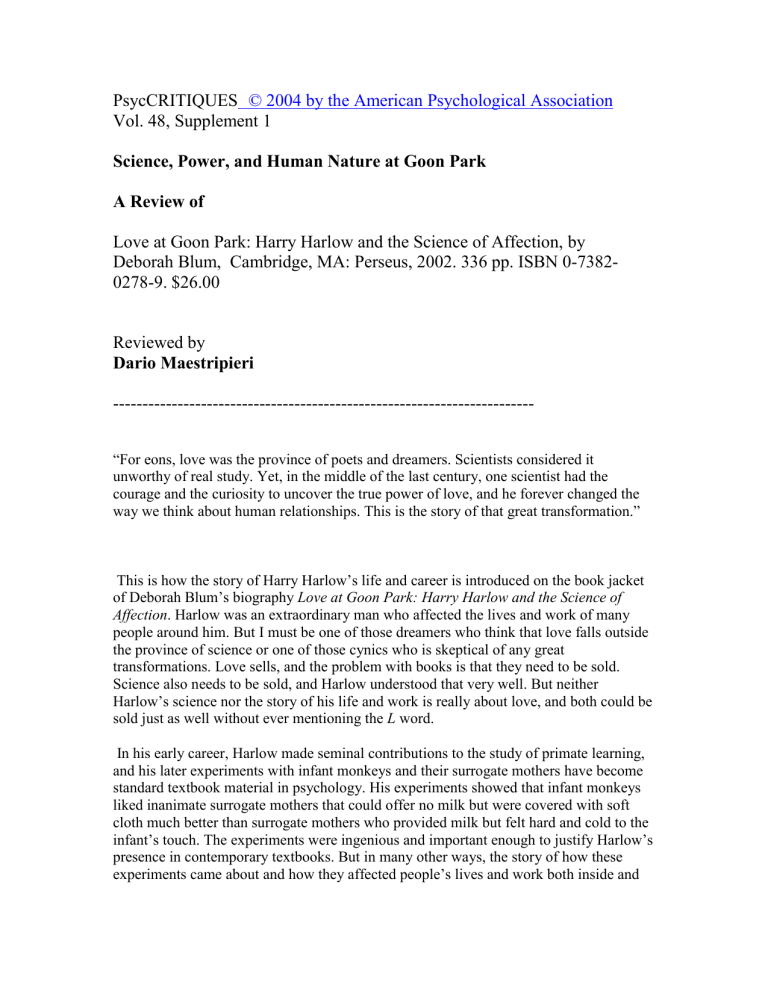
PsycCRITIQUES © 2004 by the American Psychological Association
Vol. 48, Supplement 1
Science, Power, and Human Nature at Goon Park
A Review of
Love at Goon Park: Harry Harlow and the Science of Affection, by
Deborah Blum, Cambridge, MA: Perseus, 2002. 336 pp. ISBN 0-7382-
0278-9. $26.00
Reviewed by
Dario Maestripieri
------------------------------------------------------------------------
“For eons, love was the province of poets and dreamers. Scientists considered it unworthy of real study. Yet, in the middle of the last century, one scientist had the courage and the curiosity to uncover the true power of love, and he forever changed the way we think about human relationships. This is the story of that great transformation.”
This is how the story of Harry Harlow’s life and career is introduced on the book jacket of Deborah Blum’s biography Love at Goon Park: Harry Harlow and the Science of
Affection . Harlow was an extraordinary man who affected the lives and work of many people around him. But I must be one of those dreamers who think that love falls outside the province of science or one of those cynics who is skeptical of any great transformations. Love sells, and the problem with books is that they need to be sold.
Science also needs to be sold, and Harlow understood that very well. But neither
Harlow’s science nor the story of his life and work is really about love, and both could be sold just as well without ever mentioning the L word.
In his early career, Harlow made seminal contributions to the study of primate learning, and his later experiments with infant monkeys and their surrogate mothers have become standard textbook material in psychology. His experiments showed that infant monkeys liked inanimate surrogate mothers that could offer no milk but were covered with soft cloth much better than surrogate mothers who provided milk but felt hard and cold to the infant’s touch. The experiments were ingenious and important enough to justify Harlow’s presence in contemporary textbooks. But in many other ways, the story of how these experiments came about and how they affected people’s lives and work both inside and
outside of the Harlow laboratory at Goon Park is as interesting as the experiments themselves.
How did a boy who liked to write poetry and draw pictures become a scientist? How did a scientist who studied monkeys become the president of the American Psychological
Association? How did a charismatic and successful professional become an alcoholic?
Why do people who worked with him and who professionally benefited from his legacy still maintain strong negative feelings about him more than 20 years after his death?
Blum’s biography is outstanding for the quality of investigative reporting and the amount of information it contains. The same information, however, could have been used to frame Harlow’s fascinating life and work as a window into science, power, and human nature rather than as a romantic quest for a science of love.
Like many other scientists who spend their careers studying animals, Harlow grew up on a farm where he had the opportunity to be in close contact with nature. Like many original and creative thinkers who revolutionized their fields, however, the young Harlow was not content with passively learning about the environment or “dissecting dead frogs.”
He wanted to study something that made him think, and he enjoyed himself through intellectual and creative activities such as writing poetry and painting. His success as a scientist was likely the results of his view of research as a creative activity that offers countless opportunities for original thinking and revolutionary action.
Blum devoted the second chapter of her biography to a lengthy digression on the status of children in orphanages and on research on maternal separation and infant attachment prior to Harlow’s famous experiments with monkey infants. The purpose of this chapter is to set the stage for the discussion of Harlow’s research and, to some extent, to show that he was a product of his own environment. Although it is always useful to view individuals and their lives in a historical context, in Harlow’s case it is fair to say that the individual shaped his environment more than he was shaped by it.
Chance events and serendipity play an important role in the scientific process and were also a crucial component of Harlow’s success. He began working with monkeys only because the rodent laboratory that the University of Wisconsin—Madison had promised him was never delivered. Although the times might have been ripe for his famous surrogate mother experiments, the fact remains that these experiments were stimulated by the serendipitous observation that monkey infants that were separated from their mothers for colony management purposes seemed to develop a strong attachment to their cloth diapers and became very upset every time the diapers were removed from their cages to be washed (Suomi & Leroy, 1982).
Harlow worked hard to accomplish his goals but did not mind taking shortcuts whenever possible. The story of how Harlow obtained permission from the University of
Wisconsin—Madison to build his first primate lab (by loaning the university president a monkey as a pet for his son) and built the lab with his own hands still stands, in Blum’s own words, “as a testament to determination and deviousness” (p. 83). Some of his former students describe Harlow as an opportunistic and exploitative individual who
quickly assessed people and situations around him in terms of what he could gain from them. According to Harlow, the idea for the experiments with surrogate mothers came to him while flying over Detroit: “As I turned to look out the window, I suddenly saw the vision of the cloth surrogate mother sitting beside me in all her bold and barren splendor”
(Harlow, 1977; cited in Suomi & Leroy, 1982, p. 323). His students, however, contributed some of the ideas and most of the work for the surrogate mother project, but
Harlow gave them little or no credit.
Charisma and salesmanship also were instrumental for Harlow’s success. Harlow knew how to capture an audience’s attention with choice of words and pictures and how to make bold and controversial statements that would not go unnoticed. With the findings of his work, his communication tactics, and his personal charisma, Harlow brought primate behavior research into the spotlight and, in the process, acquired a great deal of power within academia and the governmental agencies that funded his work. In the last part of his career, Harlow’s staggering power and influence over the scientific community probably contributed to the derailment of his research and possibly his mental health.
After the success of the research with surrogate mothers, Harlow launched himself into a series of bizarre experiments in which monkey infants were subjected to cruel and painful procedures, with the purpose of developing an animal model of depression. These studies did not produce useful knowledge about human depression and should not have been conducted in the first place. Nevertheless, Harlow’s power and influence were such that these studies were not overtly criticized by other scientists and were funded for many years. So the last part of Harlow’s career is a textbook example of what happens when a powerful scientist achieves full control over an area of research and his activity is no longer under the effective check of traditional peer-review mechanisms. Along with his research, Harlow’s personal life also became increasingly out of control, sinking him into alcohol addiction and depression. Nevertheless, he maintained an active group of students and post docs around him, who inherited some of his power and influence after his death and continue some of his research up to the present day.
One may think of the advancement of science as the result of the collective work of many individuals and the gradual accumulation of knowledge that results from them.
Similarly, one may think that the relative success of a scientific discipline may depend on factors such as its historical roots, whether that discipline contributes directly to improving health or quality of life, the sheer number of individuals working in the field, or the availability of funding or technology. Although these factors are certainly important, a single individual with extraordinary ideas, energy, and charisma can have a profound impact on science and influence the public’s perception of what phenomena are worth studying and how.
What is not fully apparent from Blum’s biography is that what made Harlow exceptional was not his interest in developing a science of love but his overall approach to science and his profession. Science needs individuals like Harlow, regardless of their discipline or areas of expertise, because people like him can push their field ahead and at a much faster pace by creating new areas of research or revolutionizing ways of thinking about problems. Individuals like Harlow also motivate and energize people around them,
stimulate productivity in their laboratory, and generate enthusiasm for a field of research in young students and laypeople. Eccentricity, opportunism, and self-destructiveness are often part of the package that contains brilliant minds, boundless energy, and fearless character. Love at Goon Park does a good job of describing the Harlow package but, in narrating the facts of his life and career, misses the chance to tell a story that is just as human and universal as the quest for love.
References
Suomi, S. J., & Leroy, H. A. (1982). In memoriam: Harry F. Harlow (1905–1981).
American Journal of Primatology, 2, 319-342.
